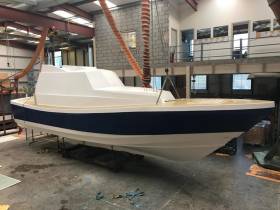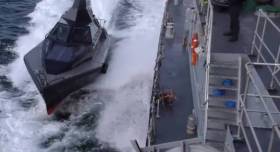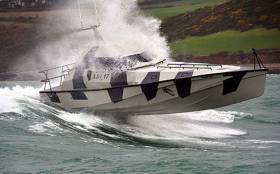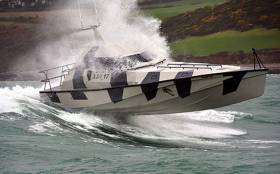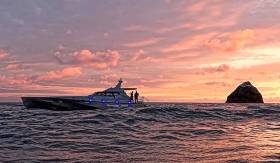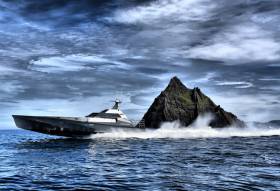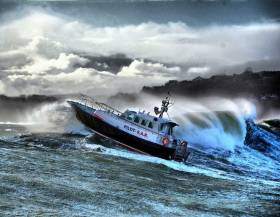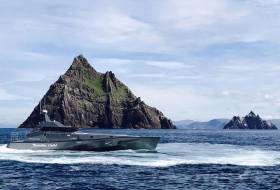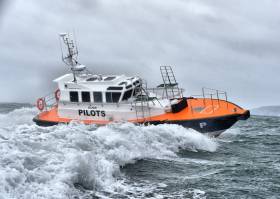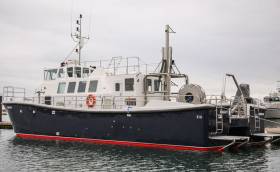Displaying items by tag: Safehaven Marine
#Safehaven - Safehaven Marine’s latest projects include a pilot boat for Malta and a survey catamaran for the UK's Royal Navy.
The Interceptor 48 pilot boat currently in production at Safehaven’s Cork Harbour boatyard is their third boat supplied to Malta Maritime Pilots in Valletta.
The all-weather vessel will add to a number already in service for ports in the Mediterranean.
An Interceptor 48 Pilot Boat currently in production for operations in Malta. This is the third pilot boat supplied to Malta by Safehaven pic.twitter.com/nYikTUk9xj
— Safehaven Marine (@SafehavenMarine) November 3, 2017
The performance boat builder has also posted video of construction on their Wildcat 60 order for the Royal Navy, showing the installation of its Volvo D16 750hp engines and jets.
Our Wildcat 60 for @RoyalNavy under construction showing engines and jets being installed #madeincork @AfloatMagazine @mbytimeinc pic.twitter.com/rQMm5niKlF
— Safehaven Marine (@SafehavenMarine) November 4, 2017
Earlier this year, the Geological Survey of Ireland took delivery of their own Wildcat 60 for offshore and shallow water coastal surveys, as previously reported on Afloat.ie.
High-Speed Boarding Trials of Cork Boatbuilders Advanced New Vessel
#militaryboat - Cobh-based boatbuilding company Safehaven Marine, has revealed footage of its new Barracuda vessel undergoing a high-speed boarding trial with the Irish Navy writes the Evening Echo.
The Barracuda which Afloat reported of its launch in 2015 is a high speed, low radar cross-section interceptor designed specifically for military and law enforcement roles.
One of the boat's most unique features is that a range of both lethal and non-lethal weapons can be concealed below deck and raised up through hatches only when required during conflict.
The Barracuda is also capable of operating with a high degree of invisibility to any opponent’s radar.
It recently underwent testing with the help of the Irish Navy and the Irish Maritime and Energy Research Cluster.
In a series of trials, the Barracuda was brought repeatedly alongside one of the naval vessels with the speeds being increased in each instance reaching a maximum of 20 knots.
According to Safehaven Marine, the vessel performed well remaining stable while alongside the naval vessel and able to break away easily.
In addition the Evening Echo notably reports separately on the construction by Safehaven Marine of an 18-metre long Wildcat 60 catamaran for the UK Ministry of Defence which will be used for a range of military purposes.
For more on this story, click here having scrolled down the page.
Rockall Record Gets Frank Kowalski Afloat.ie 'Sailor of the Month' Special Award for July
The very special powerboats of SafeHaven Marine in East Cork have multiple uses, but high speed potential in a wide variety of sea conditions is invariably top of a list of very demanding priorities among the highly-regarded company’s prestigious customers.
So when the notion of a Round Ireland and Rockall Powerboat Record first surfaced, inevitably it came from the fertile and visionary mind of SafeHaven’s Frank Kowalksi. And in July, his latest Youghal-built creation Thunder Child took on the 2000-plus kilometres challenge, going anti-clockwise and using refuelling stops at Portrush in County Antrim on the outward passage from the start/finish point of the Old Head of Kinsale, and Ballyglass on Broadhaven in Mayo on the return.
While conditions were favourable, in July’s unsettled weather there were bound to be some distinctly bumpy stages on such a long and exposed course, while many sections near land were notably tide-riven. Yet despite this, Thunder Child came back in round the Old Head of Kinsale on the evening of July 5th just 34 hours one minute and 47 seconds after departing, an average of 32 knots.
The crew of the 17m (53ft 6ins) Thunder Child who supported Frank Kowalski in this Sailor of the Month July Special Award were Ian Brownlee, Ciaran Monks, Mary Power, Peter Gurgul and Carl Randalls.
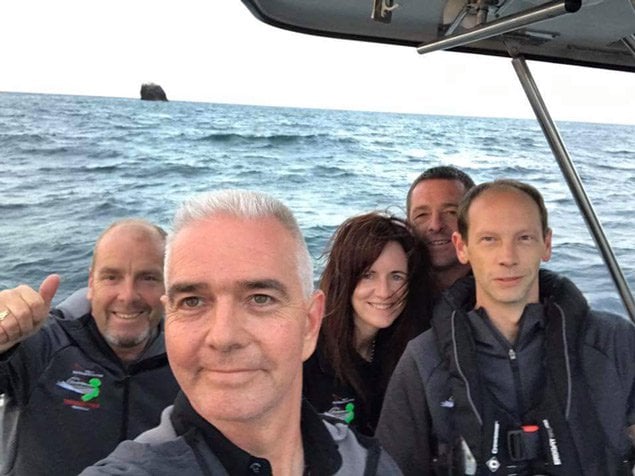 The ultimate selfie – Frank Kowalski (foreground) and the crew of Thunder Child at the small but very important ocean pinnacle of Rockall. Photo: Frank Kowalski
The ultimate selfie – Frank Kowalski (foreground) and the crew of Thunder Child at the small but very important ocean pinnacle of Rockall. Photo: Frank Kowalski
Thunderchild Round Ireland & Rockall Record Set
The Safehaven Marine team led by Frank Kowalski on Thunderchild were safely home in Cork Harbour last night with job done, and the Round Ireland & Rockall Record set at 34 hours 01 minute and 47 seconds writes W M Nixon.
This is an average speed of more than 32 knots for a total distance of more than 2000 kilometres which included long stretches of some of the often roughest ocean waters on earth.
Set on an anti-clockwise direction (the way you go is optional), the new record – the first of its kind - is now subject to ratification by Irish Sailing and the Union International Motornautique, the world governing boat for all powerboat activity.
Meanwhile, congratulations to all – the crew, the designers, and the builders in Youghal at the Safehaven plant – together with the essential shore crews who provided logistics support and the re-fuelling facilities for the crew of Frank Kowalski, Ian Brownlee, Ciaran Monks, Mary Power, Peter Gurgul and Carl Randalls. It has been an exemplary project in its planning, testing, preparation and execution.
Home Well Before Dark for Thunderchild
Apart from two essential stops at Portrush in County Antrim and Ballyglass on Broadhaven in County Mayo to take on fuel, Safehaven Marine’s challenge for a viable record for the 2000 kilometres round Ireland and Rockall, powering on with their remarkable new speed machine Thunderchild, has seen only two other stops writes W M Nixon.
One was to get a photo of the boat at Rockall itself last night, when enough daylight was available at the edge of the short northern darkness to produce a memorable and otherworldly image. And the other, specially important to a crew so closely involved with sea safety, was a pause at Black Rock off the Mayo coast this afternoon to pay their respects to the memory of the crew of air-sea rescue helicopter R 116, tragically lost on a March night four months ago in conditions very different from the summer weather which has now settled over Ireland.
But as this calm weather has followed on an unsettled period, the seas have taken time to smooth down. It’s seldom enough that Thunderchild has been able to enjoy a top speed of 52 knots in a voyage which at one stage saw her slowed back – albeit very briefly - to 20 knots. At 1845 hours this evening (Wednesday) she is at 42 knots coming in past the Fastnet, well on track to set a good time when she completes the circuit at the Old Head of Kinsale with an average speed of better than 33 knots, and neatly on time for a proper welcome home to Cobh well before dark.
 It has to be the ulltimate selfie – Frank Kowalski of Safehaven and his crewmates on Thunderchild with Rockall looking very small for a place which could be of great maritime economic significance.
It has to be the ulltimate selfie – Frank Kowalski of Safehaven and his crewmates on Thunderchild with Rockall looking very small for a place which could be of great maritime economic significance.
Safehaven Marine 'Thunder Child' Round Ireland & Rockall Speed Record Attempt Underway
Safehaven Marine began a speed record attempt around Ireland and Rockall this morning, starting from the Old Head of Kinsale writes Tom MacSweeney. The Cork company designs and builds naval and military craft, pilot and patrol boats and has been at the leading edge of speed boat design.
![]() FRank Kowalski and crew started at the Old Head of Kinsale and are heading anti–clockwise
FRank Kowalski and crew started at the Old Head of Kinsale and are heading anti–clockwise
Frank Kowalski is the Managing Director of the Company and said it looked like there was a "weather window to make our World record attempt in Thunder Child... It’s a bit marginal, but probably the best we can expect considering the current weather patterns forecast for the coming month, with continuous frontal systems moving across the North Atlantic into Ireland. Worst part looks like the West coast of Ireland with a significant wave height of 1.3m and a max of 2.2m with Force 3-4 winds Tuesday, but decreasing.
We decided to go anti-clockwise to give the swell there time to die down. Rockall is predicted at only 1m significant and 1.5m max, about as low as one could expect for North Atlantic, with light Force 2 winds. We will have a bit of weather heading off at the start Eastwards, but it’s a following sea along the South coast so we should be able to still make good speed, and then up the East coast it should be pretty calm. There is a new frontal system approaching Rockall on Wednesday with more strong winds, but we expect to be around Rockall and running ahead of that before it hits."
Safehaven Marine has signed a deal with offshore support contractor Svitzer to provide two new Interceptor 48 pilot boats for operation at the new TM2 port terminal at Tangier in Morocco.
The two 15m vessels, due for delivery in October 2018, are to be ‘all-weather capable’ and as such are self-righting, with an operational speed of 25 knots and built to a very high specification with a fully climate controlled cabin enabling comfortable transits for 8 personnel, all on shock mitigation seating.
These vessels will be the 12th and 13th Interceptor 48s produced by the Cork Harbour-based extreme performance boatbuilder, which most recently launched an Interceptor 48 last November when the P&O Cypria entered service in Limassol.
Since then the company has seen the launch of a Barracuda pilot boat at Poole in the UK, and two new boats for Spain — an Interceptor 38, Calaneras, at Algeciras, and the Interceptor 42 Vigia for the port of Gijón which was put through its paces in rough weather trials last month.
Safehaven is also the designer and builder of Thunder Child, which started its high speed trials in May ahead of its round-Ireland record attempt this summer.
Safehaven Marine’s World Record Attempt vessel Thunder Child and her crew of six departed Galway Docks after a trial run up the West Coast of Ireland.
After months of testing, this 350 kilometer run from Cork to Galway along the Atlantic coast is Thunder Childs last long-range test before her record attempt later this summer – the Long Way Round Circumnavigation of Ireland via Rockall.
The crew, under skipper Frank Kowalski, averaged 42–kts. The crew stopped off at the Skelligs off County Kerry for an hour to get some photos (see above).
The new world record bid laster this Summer is being made in the XSV 17, Safehaven's new 60–kt high speed Interceptor. The ‘Long Way Round’ circumnavigation of Ireland via Rockall, will be a near 2,000km voyage including a 1,000km run out into the North Atlantic.
THUNDER CHILD leaving Galway Bay at 34kts @SafehavenMarine @AfloatMagazine @CTribune @Galwaybayfmnews pic.twitter.com/8nSds6byEg
— Port of Galway (@portofgalway) May 29, 2017
Thunder Child left Galway this morning to return to Cork and she has already been spotted by an Afloat.ie reader off the Cliffs of Moher!
@AfloatMagazine just spotted Thunder child from @CliffsofMoher1 pic.twitter.com/I8PkYIMjff
— Pamelalucey (@pamelalucey) May 29, 2017
#CorkHarbour - Safehaven Marine in Cork Harbour has shared some images from rough weather sea trials for its latest Interceptor 42 pilot boat.
Vigia, built for the port of Gijón in northern Spain, is the 13th of its model and the 34th overall pilot vessel delivered by the Cobh-based extreme-performance boatbuilder for ports around the world.
The Interceptor 42 is powered by a pair of Volvo D13 engines rated at 500hp and achieves an operational speed at MCR of 24.5 kntos.
Vigia is fitted with pilot boarding ladders, heavily fendered all round and incorporating Safehaven’s own sacrificial fender system, protecting the vessel at its boarding area and softening the inevitable hard impact that can occur in poor conditions.
Inside, a full suite of Funruno electronics are installed at the central helm position, with seating for four pilots on Grammer suspension seats.
See more from Vigia on the Safehaven Marine Facebook page HERE.
Just arrived at Dun Laoghaire Marina is a Wildcat 60 multi purpose survey catamaran. The new vessel is the latest in the fleet for the Geological Survey of Ireland (GSI) based at Dun Laoghaire Harbour.
Cork based Safehaven Marine have delivered their Wildcat 60 / 18.5m to the national geological agency for the undertaking of both offshore and shallow water coastal surveys.
Christened ‘Mallet’ the Wildcat 60 is fitted out to undertake multi beam sonar surveys, and is capable of deploying a range of sonar’s through a moon pool in her bridge deck equipped with a hydraulic deployment system. Powered by a pair of Volvo D16 750hp engines she has a 25kts operational speed and 400nm range. Her spacious aft deck is also equipped with a knuckle boom crane, an ‘A’ frame capable of deploying equipment astern through transom gates, a 1,000kg capacity deck winch and she will be capable of RIB deployment. A crew capacity of six to eight personnel are comfortably accommodated in her dual level superstructure incorporating a raided helm position providing excellent all round visibility.
The design also provides full live aboard capabilities with sleeping facilities provided in four below deck cabins. Safehaven’s Wildcat 60 has all weather operational capabilities, reassuring when operating on the exposed Atlantic coast of Ireland.
GSI contributes to environmental protection by providing decision-makers with best available geological information from up-to-date national geological databases.
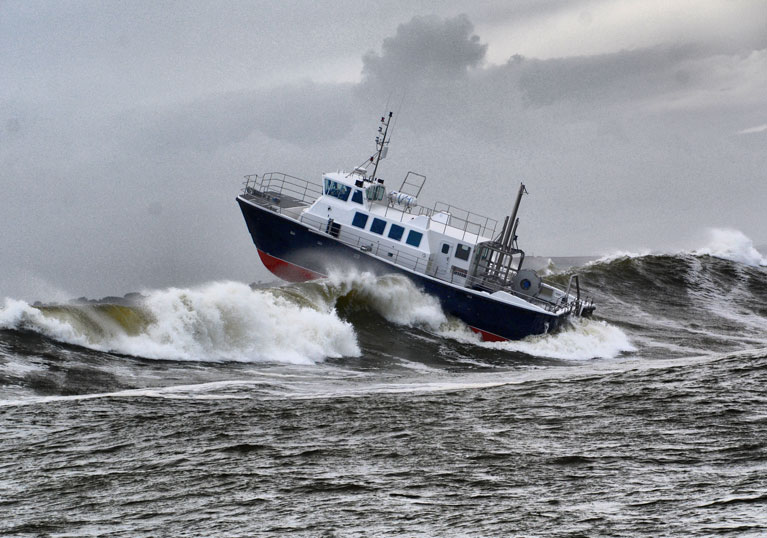 Mallet operating in heavy surf, proving her seakeeping abilities. Photo: Frank Kowalski
Mallet operating in heavy surf, proving her seakeeping abilities. Photo: Frank Kowalski
Having completed in large the mapping of the deep water Atlantic seaboard off the coast of Ireland GSI is now focusing on inshore coastal waters of Ireland and hence the requirement for a new survey vessel capable of undertaking both offshore and shallow water coastal surveys.




























